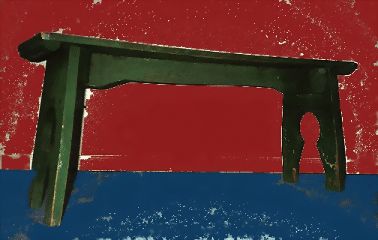The peeling paint is at the same time a sign of wear and a sign of care.
It also matches my couch, but that's not why I like it.

"During the exciting collecting days of the pre-Depression era, restorationists suggested the use of white paint for all so-called colonial interiors, and also recommended a return to natural wood for furniture of corresponding periods. The fact that the majority of light-wood pieces had originally been intended to receive a painted finish was not then generally recognized, and refinishing (with its obvious need to scrape, sand, stain, and shellac) was therefore pursued as a matter of course by all but the most knowing connoisseurs. In this way much documentation of paint colors was irrevocably lost, leaving far fewer examples for study today. Now, in the 1970s, I note with interest that "restoration" is coming full circle. Whereas I once observed old painted surfaces being scraped to the bare wood, I presently see pieces of long since refinished now being expertly repainted in a belated effort to return them to some semblance of their original appearance!
in American Painted Furniture, 1660-1880 by Dean A. Fales
layering